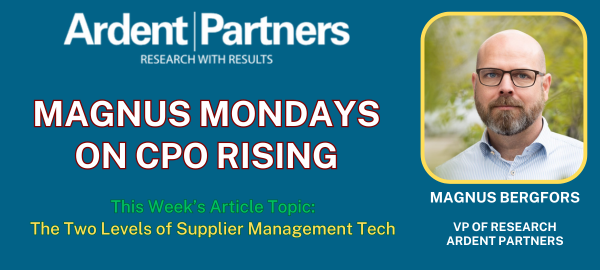Supplier management is one of the most critical aspects of procurement. But as is the case with a lot of areas within procurement, it’s complex. One of the biggest issues is that supplier management is not one thing. Depending on your perspective, it can mean a lot of different things.
Last week I had a great discussion with Sam Jenks of Kodiak Hub. He’s an American living in Sweden and bravely faced Midsummer here with pickled herring, dancing around the maypole, and many other strange Swedish customs! Part of our discussion is the many layers of supplier management.
These layers can be defined in many ways depending on how granular you want to be. But in many cases, they overlap from a technological point of view — they often need similar functionality, making some of the more granular definitions almost meaningless. That said, there are two main groups that can be identified by functionality (or solutions if you prefer). These two groups have obvious clear dependencies but also a different focus. The first group is focused on supplier data, while the second group is focused on the supplier relationship. Supplier management solution providers usually have a pretty clear origin in one or the other of these groups even if most have already expanded their capabilities into the other.
In today’s article, we will have a quick look at these two distinct areas of supplier management technology.
Cold Hard Data
The first group is focused on supplier data and is perhaps the most fundamental. Being able to onboard suppliers and maintaining correct information about them is critical to run operations. Even so, recent Ardent Partners research shows that poor data quality and/or access to it in technology is the top reason preventing greater returns or benefits from procurement technology.
However, correct supplier information is not only necessary for keeping operations running, it’s also critical from both risk and compliance management perspectives. There are more and more regulations requiring buying organizations to maintain correct and up-to-date information, ensuring their suppliers live up to various requirements ranging from slave and child labor to conflict minerals and emissions. Knowing what suppliers are used where in the organization is obviously important. If the same supplier is, unknowingly, used under different names by different parts of the organization, it could cause problems in the case of a supply disruption or if a supplier is banned for any reason.
Examples of solution providers addressing this area (but have since expanded), include HICX and Graphite Connect.
Supplier Relationship Management
The second group is more focused on the supplier relationship. These solutions support supplier performance management and supplier development and co-innovation. As mentioned, there are dependencies, and a certain amount of data is required for these purposes as well. But even if some aspect of supplier performance management is data centric, it’s what you do with the information that’s important. This leads us to supplier development which is more project oriented and requires project management and collaboration functionality.
These activities are typically more resource intensive and focused on a subset of suppliers. In many organizations, especially those that only purchase indirect materials (i.e., non-manufacturing companies), these activities are sometimes not carried out at all or done randomly.
Though this area is perhaps not as fundamental, it is as critical as the more data-centric group above. For example, if the data shows that a supplier is not living up to regulatory requirements, mitigation plans must be put in place and followed up to ensure improvements. Keeping track of supplier performance (and being able to detect trends) can also have a huge impact on the ability to serve end customers and protect the bottom line.
Examples of solution providers that have started in this area (but have since expanded) include Kodiak Hub and Vizibl.
So, when you are looking for supplier management software, it’s key to understand where your focus is. Although most of the supplier management solution providers as well as S2P suite providers cover both areas — at least with the core capabilities — the depth of functionality may differ based on the focus of the solution provider.
As always, Ardent Partners is here to help with any questions!
RELATED RESEARCH
Magnus Mondays — Graphite Connect: Supplier Management, Network Style
How New or Improved Technologies Can Transform Procurement – Supplier Management
Magnus Mondays — Supplier Portal Fatigue, a Supplier Management Issue


